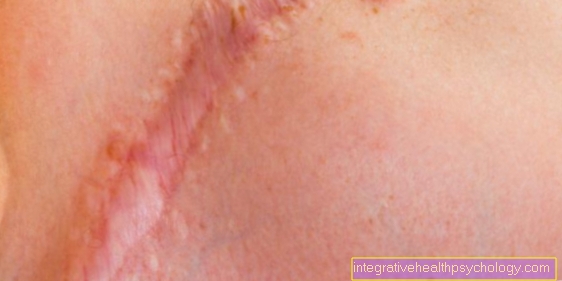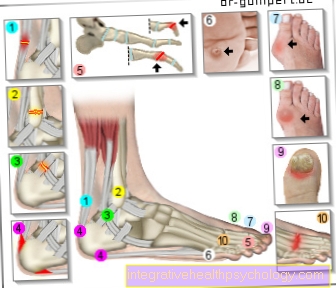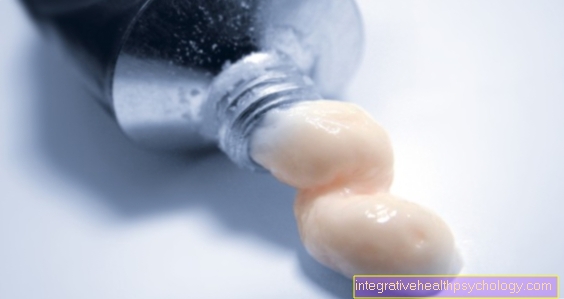Urachus fistula
Urachus fistula
introduction
The “urachus” is a duct that connects the urinary bladder with the navel.
At the beginning of the child's development in the mother's womb, this is a real connection.
At the end of pregnancy, this opening usually closes completely.
In the case of a uracheal fistula, this closure does not occur, so there is still a connection between the urinary bladder and the navel.
More information, including about the complications of a fistula on the navel, see our article: Fistula on the navel

These are the accompanying symptoms
Urine leakage can occur in the context of a uracheal fistula.
This can be noticeable in those affected by an oozing navel.
Urine contact with the skin of the navel can also cause inflammation on or around the navel.
Eczema can also develop through skin contact with urine.
Oozing navel
The oozing navel is the main symptom of an uracheal fistula.
Due to the remaining connection, the “urachus” between the bladder and the navel, urine emerges through the navel.
Usually it is only a small amount of liquid.
The leaking liquid is often noticeable by its sour, pungent odor and is usually taken as an occasion to have a clarifying physical examination carried out by a doctor.
In addition to the uracheal fistula, other diseases can also be associated with an oozing navel.
These include inflammation of the belly button due to poor hygienic care or an umbilical granuloma, i.e. tissue overgrowth on the base of the umbilicus.
Furthermore, a remaining omphaloenteric duct (yolk duct) can lead to the appearance of an oozing navel.
This is a passage that naturally exists prenatally between the intestine and the navel.
Usually this connection closes as the unborn child matures.
If there is no closure, “stool-like” secretions may escape from the navel after birth.
Here, too, the unpleasant smell, namely after a bowel movement, can provide a decisive indication of the cause of the oozing navel.
Inflammation of the belly button
Inflammation of the navel usually manifests itself as a red, swollen and tender navel.
A purulent secretion or an oozing navel can also occur in the context of an infected navel.
There are many causes of inflammation.
Above all, poor hygienic conditions can lead to inflammation.
Bacteria are the main trigger here.
In the context of a bacterial infection of the navel, the inflammation should be treated immediately in order to prevent it from spreading.
It is particularly important to start treatment quickly with babies and children in order to prevent sepsis or blood poisoning from spreading germs.
Furthermore, an inflammation can be triggered by an existing urachal duct but also by an omphaloenteric duct (yolk duct).
In the omphaloenteric duct, there is a connection between the navel and the intestine.
Feces can leak, which can ultimately lead to inflammation of the navel through contact with the skin.
In adults, for example, inflammation can also be caused by unsterile piercings. This can already arise when the piercing is stung or due to inadequate hygienic care.
If the above symptoms occur on the belly button, it is advisable to see a doctor in both children and adults.
The doctor can then use a physical examination and simple diagnostic measures such as ultrasound to determine the cause of the inflammation and initiate the appropriate therapeutic measures.
Stool leakage from the navel also occurs with a fistula in the intestine.
For more information on this, also read our related article:
Fistula in the intestine - causes & therapy
What is the reason?
The cause of a urachus fistula is based on the lack of closure of the “urachus”, i.e. the passage between the bladder and the navel.
This means that there is still a connection between the two body regions - which is then referred to as a fistula.
Urachus fistula in the baby
In babies, the uracheal fistula is due to an incomplete or non-existent closure of the uracheal duct, which connects the navel with the urinary bladder.
As a rule, the connection between the navel and the urinary bladder is already severed in the fetal period of child development.
Occasionally this does not occur and a fistula develops.
Affected babies are often noticed by leakage of fluid from the navel, which is actually small amounts of urine.
Urachus fistula in the adult
Urachus fistulas can also occur in adults.
In general, however, these are found much less often than in babies.
The cause of urachian fistula in adults is the same as that in infants.
Here, too, there is a fault in the closure or a lack of closure of the “urachus”.
So there remains a connection between the navel and the bladder.
This is how an uracheal fistula is operated
A urachus fistula is well treated surgically.
As a rule, an incision is made on the belly button and an exposure followed by severing the persistent urachal duct.
Occasionally the operation has to be extended to a laparoscopic procedure, i.e. a laparoscopy.
To do this, several small incisions are made on the abdomen and the urachal duct can be removed with the help of a camera that allows a view into the abdominal cavity.
Duration & forecast
After the surgical treatment of the uracheal fistula, those affected can basically be viewed as "cured".
The time immediately after the operation is usually associated with a period of rest of several weeks so that the wound can literally heal.
As with any surgical procedure, complications can also arise with the uracheal fistula, including infections, bleeding, etc. that can hinder the healing process.
However, these are general OP risks that can arise with every intervention.
After the surgical wound has healed, those affected usually do not have to expect any restrictions.
The prognosis of the uracheal fistula can therefore generally be regarded as very good.
diagnosis
In addition to a physical examination, an ultrasound is usually performed if an uracheal fistula is suspected.
In the best case, you can see the persistent passage between the urinary bladder and the navel in the pictures.
Occasionally, other imaging methods are also used if the visual representation with the ultrasound device does not allow a meaningful representation.
These procedures include, for example, the injection of contrast medium into the urethra with a subsequent X-ray examination.
Furthermore, in the case of an oozing navel, the escaping liquid can also be examined for certain urinary components.
If these are present, a leak of urine through a remaining urachal duct is to be regarded as likely.





























